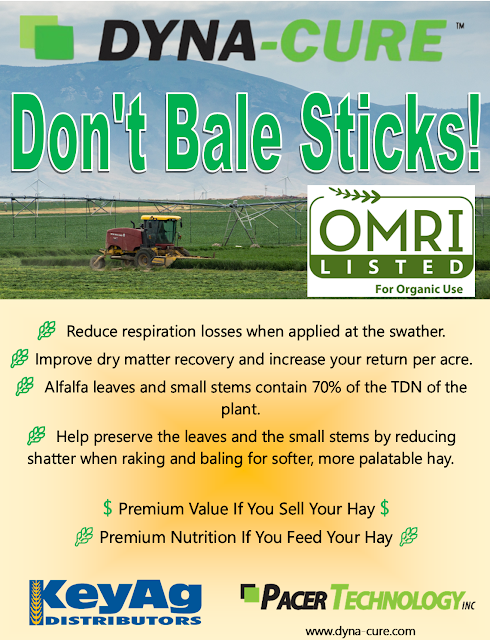Tuesday, November 26, 2024
Monday, November 25, 2024
State-By-State Hay Summary
Colorado—In the Nov. 14 report, compared to last report, trade activity moderate on light demand. Hay movement mostly on dairy and horse hay markets. Small squares of horse hay steady. Heavy, wet snow in southeast Colorado caused hay shed roofs to collapse. Recent snow has increased ranchers interest in purchasing hay. According to the NASS Colorado Crop Progress Report for week ending Nov. 10, stored feed supplies were reported at 2% very short, 6% short, 71% adequate, and 21% surplus.
Missouri—In the Nov. 15 report, compared to last report, hay prices are fully steady. The supply of hay is moderate to heavy, and demand is light. Many farmers in the south are now in clean up mode following the historic flooding in some areas. Fence repair is the most pressing task, but the removal of limbs and trash is also going to have to take place. Roads are being repaired but some are expected to take a significant amount of time and work. Even with the extreme rains other areas of the state are still dry.
Nebraska—In the Nov. 14 report, compared to last report, bales of grass and alfalfa hay sold steady. Dehydrated, sun-cured alfalfa pellets, ground and delivered hay steady.
Oklahoma—In the Nov. 8 report, compared to the last report, the hay trade is slow, not enough trade to say it is slow to steady. Rain has moved across Oklahoma and will continue to move through for most of November. This will help the drought, ponding, and crops that are in need of moisture. Movement of the trades are still mainly long-time customers and contracted hay. Even with new customers we still have an abundance of hay here in Oklahoma. Next report will be released Nov. 22.
Texas—In the Nov. 15 report, compared to last report, hay prices are mostly steady across all regions. Hay movement and demand are continuing to increase as warm season grasses are entering dormancy and cooler weather on the horizon. According to the Texas Crop Progress and Condition report, most parts of the state received anticipated rainfall over the past week. Winter wheat is beginning to make a stand in the Panhandle with the last bit of moisture. In the Southern region, cooler weather has slowed down warm season forage growth so hay production has wrapped up. Next report will be released Nov. 29.
South Dakota—In the Nov. 15 report, compared to last report, hay sales are steady with demand good with hay moving out of state and being stored in barns. Most producers are finishing up corn harvest and starting to bale corn stocks.
New Mexico—In the Nov. 8 report, compared to last week, hay demand is steady. With some of New Mexico seeing its first freeze and snow fall in the northerner parts of the state most hay production is done for the year. According to the NASS, New Mexico Crop Progress report for Nov. 3, alfalfa hay is in the sixth cutting 79% complete. While much of New Mexico remained relatively dry, heavy rainfall was noted along the eastern border stretching south from Curry County into Dona Ana County and west into Chaves County.
Wyoming—In the Nov. 14 report, compared to the last report, movement is lower than normal this past week, according to producers, movement and demand is light for this time of year all over Wyoming. According to the Wyoming Crop Progress Report, as of Nov. 12, alfalfa hay third cutting is 91% completed, other hay second cutting is 84% harvested, corn harvested for silage is completed in the state, pasture condition is 12% good condition and 33% fair condition.
Montana—In the Nov. 15 report, compared to last report, hay sold generally steady. Hay movement was heavier this week with buyers reporting more interest than the last few weeks. While interest was higher prices remain generally steady as supplies remain heavy. Demand for hay was light to moderate. Unseasonably warm weather continues to be seen across the state an many ranchers still have cows out on pasture. Hay usage remains drastically curbed this fall as open ground has allowed most of the state to graze all fall. Many ranchers still have cows and some calves out on pasture. Demand for dairy hay has lightened some. A heavier supply of dairy hay is available in Montana due to good weather this fall which allowed producers to put up lots of high quality hay. Feedlots showed some interest for high quality dairy quality hay but are not willing to pay what western dairy’s are purchasing hay for. Some producers are still trying to finish selling old crop hay. Producers have been willing to sell hay as they try to avoid excess carryover like was seen last year.







-page-001.jpg)

-page-001.jpg)
-page-002.jpg)

-page-001.jpg)
-page-002.jpg)

-page-001.jpg)
-page-002.jpg)
-page-003.jpg)
-page-004.jpg)
-page-005.jpg)




-page-001.jpg)
-page-002.jpg)

-page-001.jpg)
-page-002.jpg)
-page-003.jpg)

-page-001.jpg)
-page-002.jpg)
-page-003.jpg)
-page-004.jpg)
-page-005.jpg)

-page-001.jpg)

-page-001.jpg)
-page-002.jpg)
-page-003.jpg)

-page-001.jpg)
-page-002.jpg)
-page-003.jpg)
-page-004.jpg)

-page-001.jpg)
-page-002.jpg)
-page-003.jpg)
